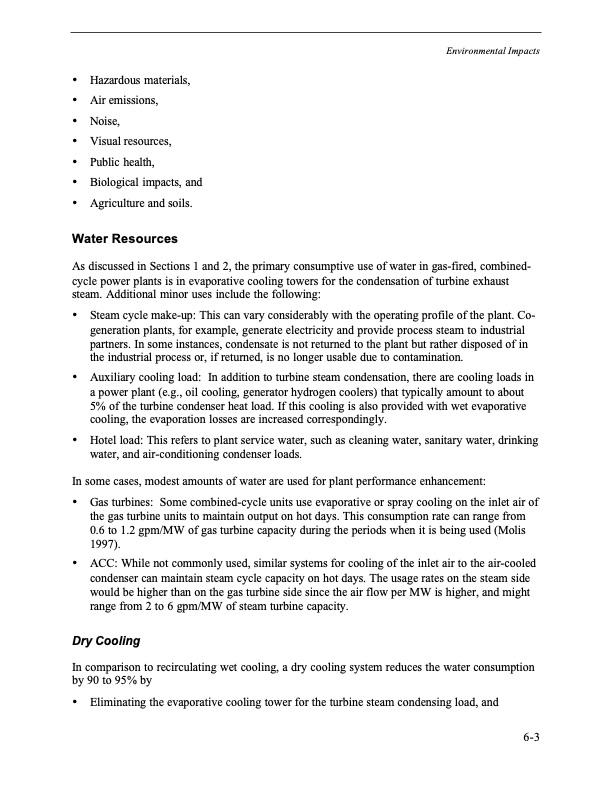
PDF Publication Title:
Text from PDF Page: 124
• Hazardous materials, • Air emissions, • Noise, • Visual resources, • Public health, • Biological impacts, and • Agriculture and soils. Water Resources As discussed in Sections 1 and 2, the primary consumptive use of water in gas-fired, combined- cycle power plants is in evaporative cooling towers for the condensation of turbine exhaust steam. Additional minor uses include the following: • Steam cycle make-up: This can vary considerably with the operating profile of the plant. Co- generation plants, for example, generate electricity and provide process steam to industrial partners. In some instances, condensate is not returned to the plant but rather disposed of in the industrial process or, if returned, is no longer usable due to contamination. • Auxiliary cooling load: In addition to turbine steam condensation, there are cooling loads in a power plant (e.g., oil cooling, generator hydrogen coolers) that typically amount to about 5% of the turbine condenser heat load. If this cooling is also provided with wet evaporative cooling, the evaporation losses are increased correspondingly. • Hotel load: This refers to plant service water, such as cleaning water, sanitary water, drinking water, and air-conditioning condenser loads. In some cases, modest amounts of water are used for plant performance enhancement: • Gas turbines: Some combined-cycle units use evaporative or spray cooling on the inlet air of the gas turbine units to maintain output on hot days. This consumption rate can range from 0.6 to 1.2 gpm/MW of gas turbine capacity during the periods when it is being used (Molis 1997). • ACC: While not commonly used, similar systems for cooling of the inlet air to the air-cooled condenser can maintain steam cycle capacity on hot days. The usage rates on the steam side would be higher than on the gas turbine side since the air flow per MW is higher, and might range from 2 to 6 gpm/MW of steam turbine capacity. Dry Cooling In comparison to recirculating wet cooling, a dry cooling system reduces the water consumption by 90 to 95% by • Eliminating the evaporative cooling tower for the turbine steam condensing load, and 6-3 Environmental ImpactsPDF Image | Comparison of Alternate Cooling Technologies for California Power Plants Economic, Environmental and Other Tradeoffs

PDF Search Title:
Comparison of Alternate Cooling Technologies for California Power Plants Economic, Environmental and Other TradeoffsOriginal File Name Searched:
2002_07_09_500_02_079F.PDFDIY PDF Search: Google It | Yahoo | Bing
NFT (Non Fungible Token): Buy our tech, design, development or system NFT and become part of our tech NFT network... More Info
IT XR Project Redstone NFT Available for Sale: NFT for high tech turbine design with one part 3D printed counter-rotating energy turbine. Be part of the future with this NFT. Can be bought and sold but only one design NFT exists. Royalties go to the developer (Infinity) to keep enhancing design and applications... More Info
Infinity Turbine IT XR Project Redstone Design: NFT for sale... NFT for high tech turbine design with one part 3D printed counter-rotating energy turbine. Includes all rights to this turbine design, including license for Fluid Handling Block I and II for the turbine assembly and housing. The NFT includes the blueprints (cad/cam), revenue streams, and all future development of the IT XR Project Redstone... More Info
Infinity Turbine ROT Radial Outflow Turbine 24 Design and Worldwide Rights: NFT for sale... NFT for the ROT 24 energy turbine. Be part of the future with this NFT. This design can be bought and sold but only one design NFT exists. You may manufacture the unit, or get the revenues from its sale from Infinity Turbine. Royalties go to the developer (Infinity) to keep enhancing design and applications... More Info
Infinity Supercritical CO2 10 Liter Extractor Design and Worldwide Rights: The Infinity Supercritical 10L CO2 extractor is for botanical oil extraction, which is rich in terpenes and can produce shelf ready full spectrum oil. With over 5 years of development, this industry leader mature extractor machine has been sold since 2015 and is part of many profitable businesses. The process can also be used for electrowinning, e-waste recycling, and lithium battery recycling, gold mining electronic wastes, precious metals. CO2 can also be used in a reverse fuel cell with nafion to make a gas-to-liquids fuel, such as methanol, ethanol and butanol or ethylene. Supercritical CO2 has also been used for treating nafion to make it more effective catalyst. This NFT is for the purchase of worldwide rights which includes the design. More Info
NFT (Non Fungible Token): Buy our tech, design, development or system NFT and become part of our tech NFT network... More Info
Infinity Turbine Products: Special for this month, any plans are $10,000 for complete Cad/Cam blueprints. License is for one build. Try before you buy a production license. May pay by Bitcoin or other Crypto. Products Page... More Info
| CONTACT TEL: 608-238-6001 Email: greg@infinityturbine.com | RSS | AMP |